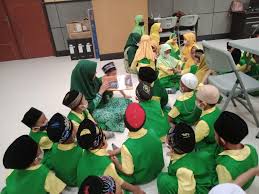Principal management in instilling Islamic character in Islamic Kindergarten
Keywords:
Principal Management, Islamic CharacterAbstract
This study is to describe the role of the principal management in instilling islamic character in TK islamic integration of the Muslim Madani. This type of study is a qualitative study with a case study approach, the data-gathering techniqused in this study is observation, interview, and documentation. The information gathered came from the headmaster and the class teacher and the companion teacher. The data analysis techniq used in the research are several stages of data condense. 2) display, and 3) verification.The study result that the headmaster's management of the imprinting of islamic character had been designed and that implementation of implementation to instill the character of islami so that schools could achieve their purposes, to evaluate more effectively so that schools could know what to lack and what to improve.
Downloads
References
Al Ghazali, A.H (1989). Ihya’ Ulumuddin, Jilid III. Beirut: Dar al Fikr
Attah, R. U., Garba, B. M. P., Gil-Ozoudeh, I., & Iwuanyanwu, O. (2024). Cross-functional team dynamics in technology management: a comprehensive review of efficiency and innovation enhancement. Eng Sci Technol J, 5(12), 3248-65.
Barnard, C.I. (1948). Organization and Management: Select Papers. Cambridge, MA: Harvard University Press.
Bahri, S., Niswanto, N., & Ismail, I. (2023). Managerial Competence of School Principals in Improving School Quality Culture in Public Elementary Schools in Banda Aceh City. International Journal of Engineering Business and Social Science, 2(01), 859-871.
Barnard, C.I. (1948). Organization and Management :Select Papers. Cambridge, MA: Harvard University Press.
Carreño, A. M. (2024). Strategic Alignment in Program Management: A Framework for Sustainable Business Transformation. Institute for Change Leadership and Business Transformation. https://doi. org/10.5281/zenodo, 13922003.
Day, C., Gu, Q., & Sammons, P. (2016). The impact of leadership on student outcomes: How successful school leaders use transformational and instructional strategies to make a difference. Educational administration quarterly, 52(2), 221-258.
Furkan, N. (2014). The implentation of character education through the school culture in sma negeri 1 dompu and sma negeri kilo dompu regency. Journal of Literature, Languages and Linguistics, 3(1), 14-44.
Izzah, I., Mulyadi, M., Walid, M., Padil, M., & Wahyudin, A. (2024). Strategic Management of Schools for Excellence: Integrating Quality Culture and Character Development in Leading Educational Institutions. AL-ISHLAH: Jurnal Pendidikan, 16(4), 4654-4668.
Jhonshon, E., Mendoza, C., & Sobirin, M. S. (2024). Strategies of School Principals in Improving Educational Quality An Analysis of Best Practices in American Schools. JMPI: Jurnal Manajemen, Pendidikan dan Pemikiran Islam, 2(2), 112-124.
Mugwaze, F., & Smith, C. (2024). Rethinking the Role of the Principal in the Strategic Management of Human Capital in Public Secondary Schools in Zimbabwe. Sage Open, 14(3), 21582440241254604.
Mustari, M., & Nurhayati, S. (2024). Multifaceted Instructional Leadership of School Principals to Improve Student Character in The Digital Era. Al-Hayat: Journal of Islamic Education, 8(2), 488-504.
Nwanakezie, I. S., & Ogona, I. K. (2021). Task development procedures for effective educational management. International Journal of Institutional Leadership, Policy and Management, 3(1), 106-133.
Nurfaidah, N., Sudirman, S., & Mellawaty, M. (2020). Bagaimanakah Cara Siswa Tunagrahita Ringan dalam Menyelesaikan Soal Operasi Hitung Pembagian?: Exploratory Case Study dalam menggunakan Media Kotak Puzzle Geometri. Kreano, Jurnal Matematika Kreatif-Inovatif, 11(2), 143-152.
O’Brien, W., Adamakis, M., O’Brien, N., Onofre, M., Martins, J., Dania, A., ... & Costa, J. (2020). Implications for European Physical Education Teacher Education during the COVID-19 pandemic: a cross-institutional SWOT analysis. European Journal of Teacher Education, 43(4), 503-522.
Půček, M. J., Ochrana, F., Plaček, M., Půček, M. J., Ochrana, F., & Plaček, M. (2021). Management in Practice: Planning, Organizing, Leading, and Controlling Museum Activities. Museum Management: Opportunities and Threats for Successful Museums, 87-137.
Rahayu, N. I. A. (2020). Kepemimpinan Kepala PAUD Di Era Revolusi Industri 4.0. Pustaka Senja, 1-149.
Shao, Z. (2019). Interaction effect of strategic leadership behaviors and organizational culture on IS-Business strategic alignment and Enterprise Systems assimilation. International journal of information management, 44, 96-108.
Sudirman, S., & Alghadari, F. (2020). Bagaimana mengembangkan kemampuan spasial dalam pembelajaran matematika di sekolah?: Suatu tinjauan literatur. Journal of Instructional Mathematics, 1(2), 60-72.
Wu, S. P. J., Straub, D. W., & Liang, T. P. (2015). How information technology governance mechanisms and strategic alignment influence organizational performance. MIS quarterly, 39(2), 497-518.

Published
How to Cite
Issue
Section
Copyright (c) 2025 Ririn Farahdiba, Muhajirin Ramzi, Lalu Marzoan

This work is licensed under a Creative Commons Attribution-ShareAlike 4.0 International License.
PIJ is licensed under a Creative Commons Attribution-NonCommercial-ShareAlike 4.0 International License.
Articles in this journal are Open Access articles published under the Creative Commons CC BY-NC-SA License This license permits use, distribution and reproduction in any medium for non-commercial purposes only, provided the original work and source is properly cited. Any derivative of the original must be distributed under the same license as the original.







